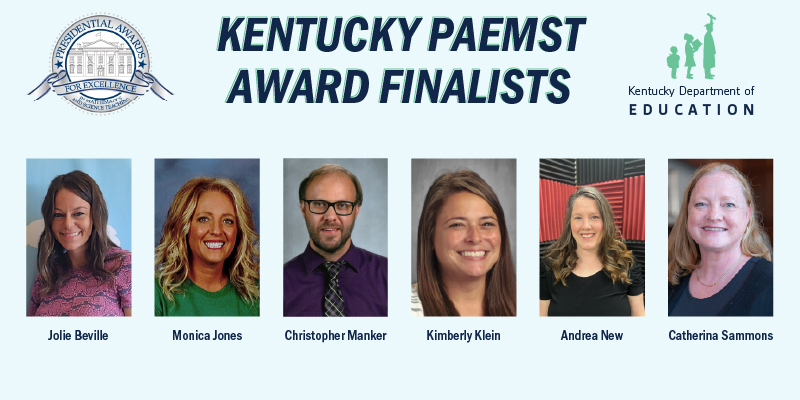
Cheyenne Mills
By Cheyenne Mills
cheyenne.mills@boyle.kyschools.us
This summer, I had the opportunity to work on revising and reflecting on the science through- course tasks at the Kentucky Department of Education (KDE) with other talented educators.
After this experience and implementing a through-course task (TCT) in my own 4th-grade classroom, I want to sing its praises! The TCTs are wonderful tools that support how teachers and administrators look at science instruction and how we gather evidence of student learning related to the three dimensions of the science standards.
At Woodlawn Elementary School (Boyle County), where I teach, our school leadership facilitated the through-course task process plan with teachers during our weekly professional learning community (PLC) meetings.
Our administrators followed the recommended through-course task process with fidelity. As a result of that, I feel that we – as teachers – had a deeper understanding of the task and what it was designed to do. However, from my conversations with other Kentucky teachers, not everyone had this experience.
During the process of evaluating and annotating through-course tasks at KDE, I heard and read a lot of comments from educators on the task and the process of facilitation. It seems that, in a lot of schools, the teachers saw this task as another thing to check off of a to-do list that was given to them by their administrators. A lot of teachers felt that it was simply another test and another tool that would be used to hold them accountable.
In my school, we definitely did not feel this way. Using the recommended collaborative process allowed us to facilitate the TCT in a way that was meaningful for our students and ourselves.
The first step of the recommended process was planning for task facilitation. My 4th-grade science partner, Alyssa Miller, and I worked together to plan when and how we would facilitate the through-course task. We worked to gain a deep understanding of the purpose of the task before facilitation.
The very first thing we did when we were given the task that we were to use with our 4th-graders – Bundles of Joy – was to complete it ourselves. I think that this was, if pressed to choose, the single most meaningful piece of the planning that we completed. I think that reading and completing the task helped us to get into the minds of our students and consider exactly what we were going to be asking of them. We analyzed the same patterns the students would later analyze and drew our own conclusions about what the patterns showed. We were able to consider the specific wording of the prompt and the questions, and think about what scaffolding we would need to provide in order to help our students be successful.
This step also helped us considerably when we worked on another process – creating our own rubrics based on the success criteria. We were able to evaluate our own worked based on the success criteria and think about what we would be looking for when considering student work. By evaluating our own work, we were able to have a deeper understanding of the success criteria and the different ways a student might meet that criteria.
We both evaluated each other’s work as well, and while they differed in a lot of ways, we did both meet the success criteria. This helped us to think about all of the student answers we would receive and how there were multiple possible “right” answers for this task. This task was more about using proper evidence and reasoning based on patterns, rather than getting a specific answer. This also showed us how truly robust and useful the task was. Focusing on probing student sense-making rather than their ability to find a “right” answer helps us to think about whether we are truly equipping our students with important 21st century skills.
I think, frankly, the facilitation process itself may have been our weakest area. We did not document our processes as well as I would have liked, such as our feedback questions and other strategies that we used to facilitate the task to best suit our needs and our students’ needs. While we did plan for and discuss this beforehand, we didn’t well document what actually occurred as we facilitated the task. During this school year, I certainly plan to video the facilitation process and reflect upon it with my partner teacher, as well as compare our strategies and what they elicited from students.
After we facilitated the task, we came back together at another weekly PLC to discuss our student work. We read our student work before we had our discussion, but we did not annotate it or evaluate it in any way. We wanted to discuss what we had noticed first.
Of course, Kentucky is moving toward a new model of accountability, one that seeks to evaluate students’ sense-making abilities rather than their knowledge stores. The TCTs are a perfect way to do just that.
The TCTs are not tethered to specific disciplinary core ideas, rather, they are focused on probing and assessing students’ ability to use cross-cutting concept schemas and the science and engineering practices. To some, this is scary. The disciplinary core ideas are most similar to “knowledge targets” and are typically easier to assess because they are more straightforward and there is a clearer “yes” or “no” answer to the question of student understanding. A student’s ability to make sense of data and phenomenon is much more difficult to assess.
But this is the entire value of the TCTs! They are an extraordinary tool to help probe and assess these skills that are more abstract and less straightforward.
The best part about the TCT process is that it is designed to help you do this work of assessment by collaborating with your peers. Two heads are better than one and discussing the TCTs with your fellow teachers is an essential part of the process. This is when things begin to open up and you are able to compare student thinking and discuss what you noticed in a way that helps you get to know your students’ sense-making abilities.
Often it may be difficult to assign a number or letter grade to this work, and that’s OK. The TCTs are for you and your students. While we are being asked by the KDE to implement these tasks, they are not a part of any evaluative process for KDE and they do not factor into our school’s rating.
Through-course tasks are a tool that we are being offered to help us meet the needs of our 21st century learners. I, for one, am extremely grateful for the opportunity both to implement them with my students and be a part of the creation process as well.
Cheyenne Mills is a 4th-grade math and science teacher at Woodlawn Elementary School (Boyle County). She earned her bachelor’s degree in elementary education from the University of Kentucky and is now pursuing her master’s degree in STEM education from UK.




Leave A Comment